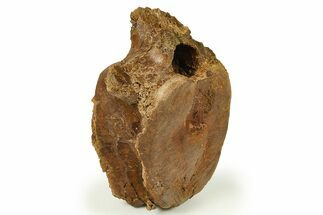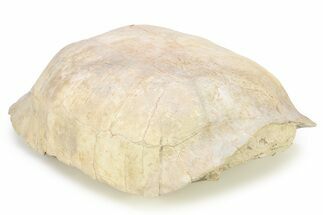This Specimen has been sold.
44" Massive Hadrosaur Femur With Metal Stand - 38 Foot Adult!
This is a gigantic, 44" long adult hadrosaur femur (upper leg bone) from the right leg, collected from the Lance (Creek) Formation of Niobrara County, Wyoming. It comes from the species Edmontosaurus annectens and is Upper Cretaceous in age, or approximately 66 million years old. This specimen is the second largest hadrosaur femur we've had available!
Fun fact: One of the largest complete Edmontosaurus annectens (AMNH 5730) skeletons has a total length of just under 12 meters (39 feet) and a femur length of 114.8 centimeters (45.19 inches). This femur here is about the an inch shorter (111.76 centimeters / 44 inches), meaning it's safe to say the complete length of the hadrosaur this femur is from was nearly the size of AMNH 5730.
The femur comes with the pictured custom metal display stand. It has been photographed in the stand with both the anterior (cranial) and posterior (caudal) faces showing. It can sit nicely on the stand either way.
This bone is beautifully intact with less repair and restoration than our largest, most recent femur. The majority of restoration can be found throughout the distal epiphysis where several sections of the bone were unrecoverable. Some additional gap fill restoration can be found along the posterior face of the diaphysis. Repaired cracks can also be found through the diaphysis and both epiphyses. The fourth trochanter is approximately 90% complete (10% restored) which is incredible considering this fragile feature is typically destroyed over the million of years within the ground. Overall, restoration makes up approximately 2% of the bone.
Fun fact: One of the largest complete Edmontosaurus annectens (AMNH 5730) skeletons has a total length of just under 12 meters (39 feet) and a femur length of 114.8 centimeters (45.19 inches). This femur here is about the an inch shorter (111.76 centimeters / 44 inches), meaning it's safe to say the complete length of the hadrosaur this femur is from was nearly the size of AMNH 5730.
The femur comes with the pictured custom metal display stand. It has been photographed in the stand with both the anterior (cranial) and posterior (caudal) faces showing. It can sit nicely on the stand either way.
This bone is beautifully intact with less repair and restoration than our largest, most recent femur. The majority of restoration can be found throughout the distal epiphysis where several sections of the bone were unrecoverable. Some additional gap fill restoration can be found along the posterior face of the diaphysis. Repaired cracks can also be found through the diaphysis and both epiphyses. The fourth trochanter is approximately 90% complete (10% restored) which is incredible considering this fragile feature is typically destroyed over the million of years within the ground. Overall, restoration makes up approximately 2% of the bone.
Edmontosaurus is one of the largest Hadrosaurs, and one of the most widespread: fossil remainshave been found across western North America, from Colorado to northern Alaska. This large herbivore was about the same size as the contemporary predator Tyrannosaurus, reaching 39 feet in length and an average weight of about 6 tons. Named after Edmonton, the capital of the Canadian province of Alberta where its first fossils were discovered, Edmontosaurus was a gregarious terrestrial herbivore that ground up low-lying plant material with its large battery of ever-restoring teeth. Numerous skin impressions and mummified specimens show us that Edmontosaurus had scaly skin, and its forelimbs were enclosed in a fleshy "mitten" serving a purpose similar to a hoof. Edmontosaurus was a member of the Saurolophine clade of Hadrosaurs, meaning they had little to nonexistent crests on the backs of their skulls.
The Lance Formation of Wyoming, which dates back to the Late Cretaceous period between 66 and 69 million years ago, is home to a wide variety of both dinosaur and assorted small vertebrate fossils. During the Cretaceous, this midwestern formation would have been comprised of streams connected to the large Western Interior Seaway that split continental North America in half down the midwest. As a result of the subtropical climate and frequent rainfall, life flourished both on land and in the sea. These wet environments created perfect scenarios for sediment deposition, making the resulting Lance Formation such a fertile fossil site.
Perhaps the most famous Lance resident would be Tyrannosaurus rex, the largest North American carnivore to ever live. However, other smaller theropods also roamed the American midwest in this subtropical coastal stream system, including the beaked Ornithomimus, a lanky running theropod with a build similar to a modern ostrich, as well as several small predatory troodonts such as Paronychodon and Pectinodon.
Herbivorous dinosaurs also took advantage of the abundance offered by this unique era. Armored ankylosaurs dwelt in herds, their safety assured by their numbers, their heavy bone plating protecting most of their bodies and even their eyelids, and huge bone clubs on the ends of their tails providing them with powerful offensive capabilities. Ceratopsians like the famous Triceratops also formed protective herds, guarding their necks with frills and horns. Their smaller relatives, the dome-headed pachycephalosaurs, were also well represented in the area. Hadrosaurs, duck-billed titans with huge batteries of plant-grinding teeth in elongated snouts, are also well known from the region.
In addition to dinosaurs, a wide variety of fishes, amphibians, lizards, snakes, turtles, champsosaurs, crocodilians, and pterosaurs have been found in the formation.
Perhaps the most famous Lance resident would be Tyrannosaurus rex, the largest North American carnivore to ever live. However, other smaller theropods also roamed the American midwest in this subtropical coastal stream system, including the beaked Ornithomimus, a lanky running theropod with a build similar to a modern ostrich, as well as several small predatory troodonts such as Paronychodon and Pectinodon.
Herbivorous dinosaurs also took advantage of the abundance offered by this unique era. Armored ankylosaurs dwelt in herds, their safety assured by their numbers, their heavy bone plating protecting most of their bodies and even their eyelids, and huge bone clubs on the ends of their tails providing them with powerful offensive capabilities. Ceratopsians like the famous Triceratops also formed protective herds, guarding their necks with frills and horns. Their smaller relatives, the dome-headed pachycephalosaurs, were also well represented in the area. Hadrosaurs, duck-billed titans with huge batteries of plant-grinding teeth in elongated snouts, are also well known from the region.
In addition to dinosaurs, a wide variety of fishes, amphibians, lizards, snakes, turtles, champsosaurs, crocodilians, and pterosaurs have been found in the formation.
SPECIES
Edmontosaurus annectens
LOCATION
Niobrara County, Wyoming
FORMATION
Lance (Creek) Formation
SIZE
Bone 44" long, 44" tall on stand
CATEGORY
SUB CATEGORY
ITEM
#264866
We guarantee the authenticity of all of our
specimens. Read more about our
Authenticity Guarantee.
specimens. Read more about our
Authenticity Guarantee.
 Reviews
Reviews


















